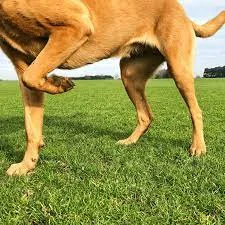A Comprehensive Guide to Dog Sprains and Strains
Dog leg sprains can be a common concern for pet owners, affecting our beloved furry companions unexpectedly. In this comprehensive guide, we will explore everything you need to know about preventing, treating, and caring for your dog during a leg sprain. Our expert advice and valuable insights will help you ensure your canine friend’s well-being and support their journey to a speedy recovery.
Table of Contents
- Understanding Dog Sprains and Strains
- Recognizing the Symptoms
- Diagnosing Dog Sprains and Strains
- Prevention of Dog Leg Sprains
- Maintaining a Healthy Weight
- Regular Exercise and Conditioning
- Warm-up and Cool-down
- Avoiding Excessive Jumping or Rough Play
- Treatment Options for Dog Leg Sprains
- Rest and Restricted Activity
- Cold Therapy
- Pain Management
- Physical Therapy and Rehabilitation
- Supportive Measures
- Healing Time for Dog Leg Sprains
- Home Remedies for Dog Leg Sprains
- Gentle Massage
- Providing Comfort and Support
- Identifying Dog Leg Sprains vs. Fractures
- Rehabilitation Exercises for Dog Leg Sprains
- Conclusion
- FAQs (Frequently Asked Questions)
Understanding Dog Sprains and Strains
Sprains and strains are two different types of injuries that can affect dogs. Understanding the difference between them is crucial to providing appropriate care.
A sprain occurs when a ligament (the tissue that connects bones) is stretched or torn due to excessive force or trauma. On the other hand, a strain refers to an injury to a muscle or tendon (the tissue that connects muscles to bones).
Both sprains and strains can cause pain, discomfort, and limited mobility for your furry friend.
Recognizing the Symptoms
Being able to recognize the symptoms of sprains and strains is important for early detection and timely intervention. Here are some common signs that your dog may be experiencing a sprain or strain:
- Limping or favoring one leg
- Swelling, bruising, or tenderness around the affected area
- Reluctance to bear weight on the injured limb
- Whining or yelping when the area is touched or manipulated
- Changes in gait or difficulty moving
- Decreased activity or unwillingness to engage in physical activities
Diagnosing Dog Sprains and Strains
While recognizing the symptoms is crucial, it’s also important to obtain a proper diagnosis from a veterinarian. The veterinarian will perform a thorough examination and may recommend additional tests, such as X-rays or ultrasounds, to assess the extent of the injury. A proper diagnosis will guide the treatment plan and ensure the best possible outcome for your dog.
Preventing Dog Sprains and Strains

Dog-Leg-Sprains
Prevention is always better than cure. While some injuries are inevitable, you can take proactive steps to minimize the risk of sprains and strains in your dog:
Maintain a Healthy Weight
Excess weight puts strain on your dog’s joints and increases the risk of injuries. Maintaining a healthy weight for your dog is essential, as excess weight can strain their joints and ligaments, making them more susceptible to injuries. Regular exercise and conditioning play a important role in strengthening their muscles and improving flexibility, lowering the chances of sprains during physical activities.
Regular Exercise and Conditioning
Engage your dog in regular exercise and conditioning activities to keep their muscles strong and flexible. Gradual and controlled physical activity will help prevent injuries.
Warm-up and Cool-down
Before any strenuous exercise or activity, make sure to warm up your dog’s muscles with a gentle walk or light play. Similarly, incorporate a cool-down period to gradually reduce their activity level.
Avoid Excessive Jumping or Rough Play
Monitor your dog’s playtime and discourage excessive jumping or rough play that may lead to injuries. Provide appropriate toys and engage in activities that are safe and suitable for their size and breed.
Rehabilitation Exercises for Dog Leg Sprains
As your dog progresses in their healing journey, gradual rehabilitation exercises under professional guidance can aid in improving their strength, flexibility, and mobility. These exercises can help them regain their range of motion and prevent stiffness in the affected leg.
Treatment Options for Dog Sprains and Strains
The treatment approach for sprains and strains depends on the severity of the injury. Here are some common methods used to manage and aid in the recovery process:
Rest and Restricted Activity
Rest is crucial for the healing process. Your dog will need to avoid activities that may worsen the injury. Restrict their movement by confining them to a safe and comfortable space.
Cold Therapy
Applying cold compresses or ice packs to the affected area can help reduce swelling and alleviate pain. Be sure to wrap the cold pack in a towel to protect your dog’s skin.
Pain Management
Your veterinarian may prescribe pain medication or recommend over-the-counter options to manage your dog’s pain. Follow the prescribed dosage and consult your vet if you have any concerns.
Physical Therapy and Rehabilitation
In some cases, physical therapy and rehabilitation exercises may be recommended to improve strength, flexibility, and mobility. These exercises should be performed under the guidance of a professional to avoid further injury.
Supportive Measures
Depending on the severity of the injury, your dog may benefit from additional supportive measures such as splints, bandages, or braces. These aids provide stability and support during the healing process.
Healing Time for Dog Leg Sprains
The recovery period for dog leg sprains can vary depending on the severity of the injury. Milder sprains may heal within a few weeks with proper care, while more severe cases might take several weeks or even months. It’s crucial not to rush their recovery and to follow your veterinarian’s guidance diligently, allowing their body ample time to heal.
Home Remedies for Dog Leg Sprains
While professional veterinary care is essential for severe sprains, there are some home remedies you can try to provide comfort to your furry friend. Gentle massage around the affected area can promote relaxation and alleviate tension. Keeping them calm and comfortable during the healing process is essential, and you can elevate the injured leg slightly with the help of a pillow or cushion to reduce swelling.
Identifying Dog Leg Sprains vs. Fractures
It can be challenging to distinguish between a leg sprain and a fracture, as some symptoms may overlap. In cases of fractures, there might be a noticeable cracking sound at the time of injury, severe swelling, or visible bone displacement. On the other hand, sprains typically involve milder swelling and tenderness without obvious deformities. If in doubt, always seek immediate veterinary attention for an accurate diagnosis.
How do you prevent a sprain on a dog?
To prevent a sprain on a dog, you can follow these preventive measures:
- Maintain a healthy weight for your dog to reduce strain on their joints and ligaments.
- Provide regular exercise and conditioning to keep their muscles strong and flexible.
- Warm up your dog’s muscles with a gentle walk or light play before engaging in strenuous activities.
- Avoid excessive jumping or rough play that may lead to injuries.
- Use appropriate toys and engage in activities suitable for your dog’s size and breed.
Will a dog’s sprained leg heal on its own?
A dog’s sprained leg may or may not heal on its own, depending on the severity of the injury. Mild sprains may resolve with rest and proper care, while more severe sprains may require veterinary treatment.
How long does it take for a dog’s sprained leg to heal?
The healing time for a dog’s sprained leg varies based on the severity of the injury and the individual dog’s healing ability. Generally, mild sprains may take a few weeks to heal, while more severe sprains may take several weeks or even months.
Can you treat a dog sprain at home?
Treating a dog sprain at home can be done with the following steps:
- Rest: Restrict your dog’s movement and limit their physical activity.
- Cold Therapy: Apply cold compresses or ice packs wrapped in a towel to the affected area to reduce swelling and pain.
- Pain Management: Consult your veterinarian for appropriate pain medication options.
- Support: Depending on the severity of the sprain, your dog may benefit from supportive measures such as splints, bandages, or braces.
- Physical Therapy: Under professional guidance, perform rehabilitation exercises to improve strength, flexibility, and mobility.
While mild sprains may heal with home care, it’s important to consult your veterinarian for a proper diagnosis and guidance on the best treatment approach.
The recovery time for a dog’s sprained leg depends on the severity of the injury. Mild sprains may take a few weeks to heal, while more severe sprains can take several weeks or even months. It’s crucial to follow your veterinarian’s advice and monitor your dog’s progress during the recovery process.
Will a dog’s sprained leg heal on its own?
While some sprains may heal on their own, it’s important to consult your veterinarian for an accurate diagnosis and to ensure the appropriate treatment plan for your dog’s specific situation.
Dog sprained front paw?
If a dog has a sprained front paw, they may show symptoms such as limping, swelling, tenderness, and reluctance to bear weight on the affected paw. It’s important to have a veterinarian examine the paw to determine the extent of the injury and provide appropriate treatment.
Dog sprained back leg?
If a dog has a sprained back leg, they may exhibit similar symptoms as a front paw sprain, including limping, swelling, tenderness, and reluctance to bear weight. A proper diagnosis from a veterinarian is crucial to determine the extent of the injury and provide appropriate care.
Dog leg sprain symptoms?
Symptoms of a dog leg sprain may include limping, swelling, bruising, tenderness, changes in gait, and difficulty moving. However, it’s important to note that these symptoms can also indicate other injuries or conditions. Consulting with a veterinarian is necessary to accurately identify a leg sprain and rule out any other potential issues.
How to identify dog leg sprain vs break?
When differentiating between a dog leg sprain and a break, several factors can help distinguish between the two:
- Sound: When a break occurs, it may produce a cracking or snapping sound. A sprain usually does not cause such a sound.
- Swelling: Both sprains and breaks can cause swelling, but severe swelling or deformity is more indicative of a break.
- Deformity: A break may cause a visible deformity in the affected leg, such as an obvious misalignment or an abnormal angle, while a sprain may not cause any visible deformity.
- Weight-Bearing: Dogs with a sprain may still bear weight on the affected leg, although with difficulty, while dogs with a break are more likely to avoid bearing any weight on the injured leg.
It’s important to consult a veterinarian for an accurate diagnosis through physical examination and imaging tests like X-rays to determine whether a dog has a leg sprain or a break.
Dog leg pain home remedies?
When a dog experiences leg pain, several home remedies may provide temporary relief, but it’s important to remember that these remedies are not substitutes for professional veterinary care. Here are some options to consider:
- Rest: Ensure your dog gets plenty of rest and avoids activities that may exacerbate the pain.
- Cold Compress: Apply a cold compress or ice pack wrapped in a towel to the affected area for short intervals to reduce inflammation and alleviate pain.
- Massage: Gently massage the muscles surrounding the leg to promote relaxation and alleviate tension.
- Elevation: If the leg allows, elevating it slightly with the help of a pillow or cushion may reduce swelling and discomfort.
- Pain Medication: Over-the-counter pain medication should only be used under veterinary guidance, as certain medications can be toxic to dogs.
It’s crucial to consult a veterinarian to identify the underlying cause of the leg pain and receive appropriate treatment.
How to identify dog leg sprain vs break?
It can be challenging to distinguish between a leg sprain and a fracture, as some symptoms may overlap. In cases of fractures, there might be a noticeable cracking sound at the time of injury, severe swelling, or visible bone displacement. On the other hand, sprains typically involve milder swelling and tenderness without obvious deformities. If in doubt, always seek immediate veterinary attention for an accurate diagnosis.
Differentiating between a dog leg sprain and a break can be challenging, but there are a few key factors to consider:
- Sound: When a break occurs, it may produce a cracking or snapping sound. A sprain usually does not cause such a sound.
- Swelling and Deformity: Breaks often cause severe swelling, deformity, or visible bone displacement, while sprains may have milder swelling and tenderness without visible deformity.
- Weight-Bearing: Dogs with a sprain may still bear weight on the affected leg, although with difficulty, while dogs with a break are more likely to avoid bearing any weight on the injured leg.
It’s crucial to consult a veterinarian for a thorough examination, including X-rays, to accurately identify a dog’s leg injury as a sprain or a break.
FAQs
1. How common are dog leg sprains?
Dog leg sprains are relatively common. They can occur due to various reasons such as sudden movements, slips, falls, or overexertion during physical activities.
2.Can my dog walk on a sprained leg?
Depending on the severity of the sprain, your dog may still attempt to walk on the affected leg, but they may limp or show signs of discomfort. It’s essential to limit their movement and seek veterinary care to prevent further injury.
3. Should I wrap my dog’s sprained leg?
It is generally not recommended to wrap a dog’s sprained leg without proper guidance from a veterinarian. Improper wrapping can cause additional harm or hinder the healing process. Seek veterinary advice for appropriate support or splinting measures.
4. How long should I restrict my dog’s activity after a leg sprain?
The duration of activity restriction depends on the severity of the sprain and your veterinarian’s recommendation. Mild sprains may require a few days to a couple of weeks of limited activity, while more severe sprains may require several weeks or even months of restricted movement.
5. When should I seek veterinary care for my dog’s leg sprain?
It is advisable to seek veterinary care if your dog’s leg sprain is severe, causing intense pain, significant swelling, or if your dog is unable to bear weight on the affected leg. Additionally, if the sprain does not improve within a few days or if you notice any other concerning symptoms, consult a veterinarian for proper evaluation and guidance.
6. Can a dog re-injure a previously sprained leg?
Yes, dogs can re-injure a previously sprained leg, especially if the proper healing time and rehabilitation protocols were not followed. It’s important to provide adequate rest, follow veterinary advice, and gradually reintroduce physical activity to minimize the risk of re-injury.
7. How can I prevent future leg sprains in my dog?
To reduce the risk of future leg sprains, maintain a healthy weight for your dog, engage them in regular exercise and conditioning activities to strengthen their muscles, and avoid excessive jumping or rough play. Additionally, provide appropriate toys and activities suitable for their size and breed to minimize the chances of injury.
Remember, if you have any concerns or questions about your dog’s leg sprain, it is always best to consult with a qualified veterinarian for proper diagnosis and guidance.
Conclusion
With proactive preventive measures, timely treatment, and attentive care, you can effectively manage dog leg sprains and ensure a smooth recovery for your canine companion. Remember, always consult with your veterinarian for personalized advice and guidance tailored to your dog’s specific needs. By prioritizing their well-being and providing appropriate care, you can help them overcome leg sprains and minimize the risk of future injuries.







Leave a Comment
You must be logged in to post a comment.